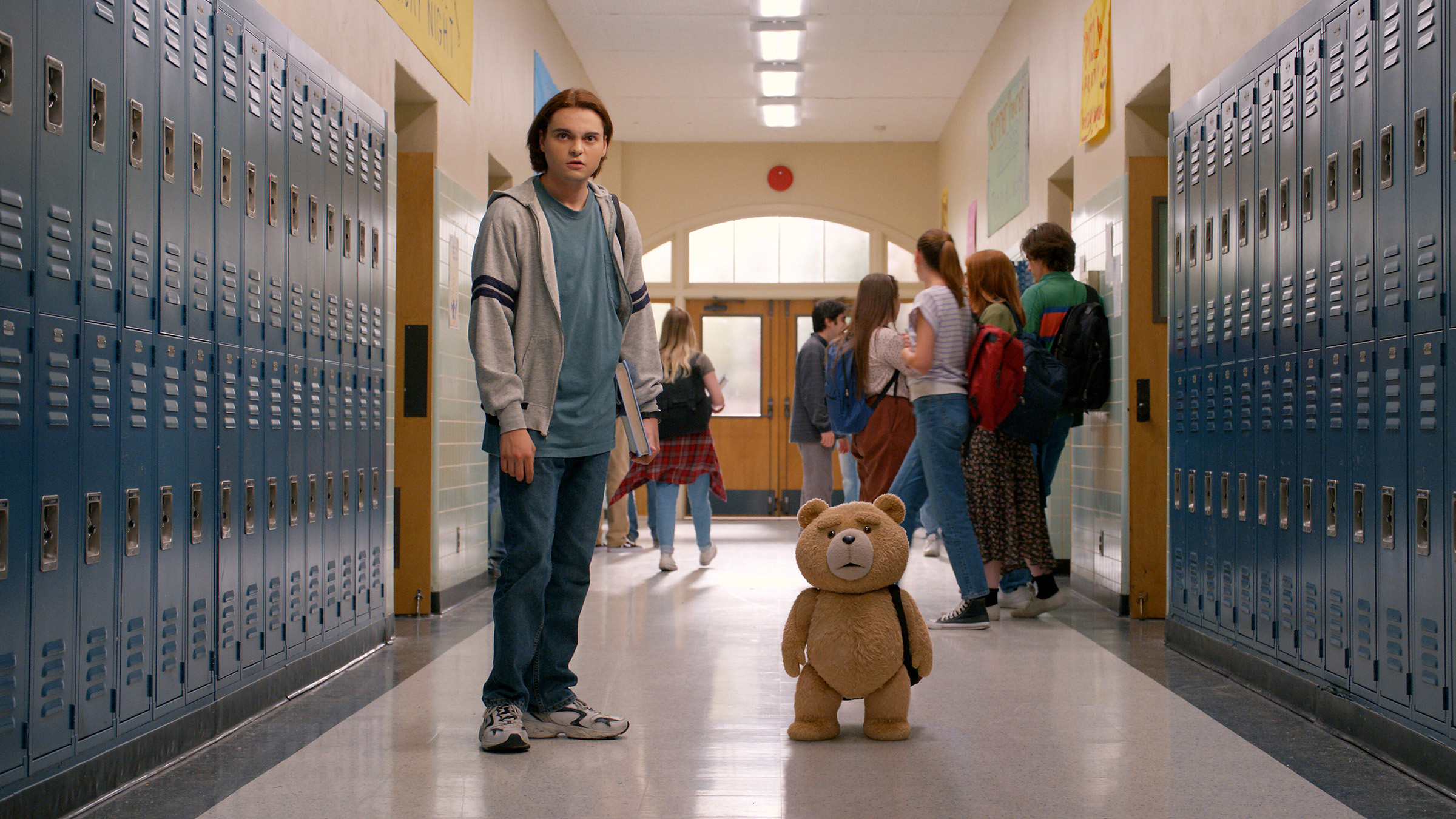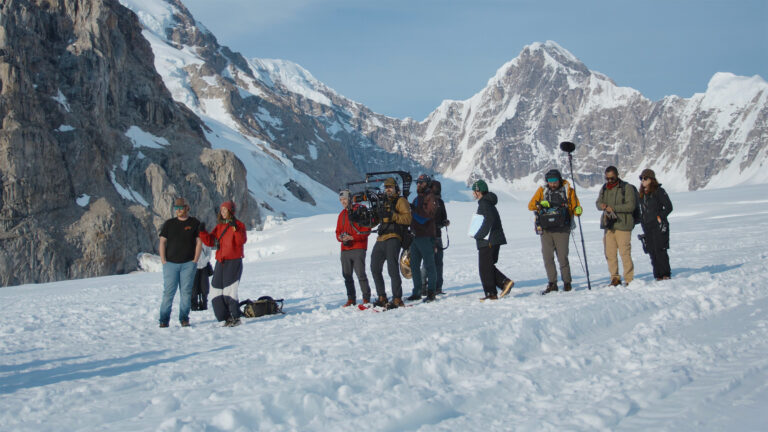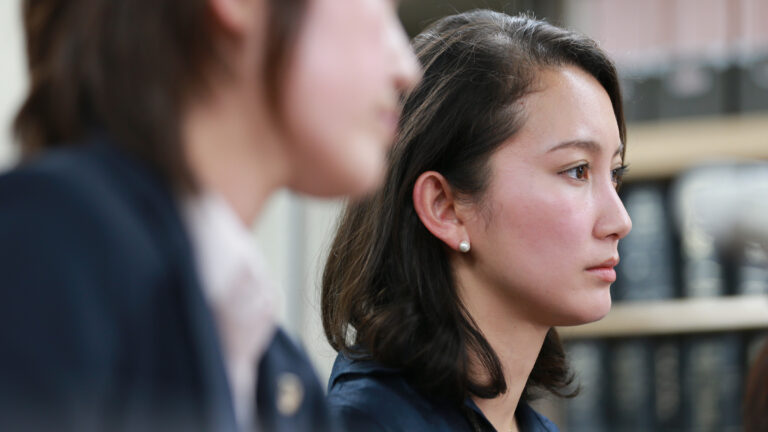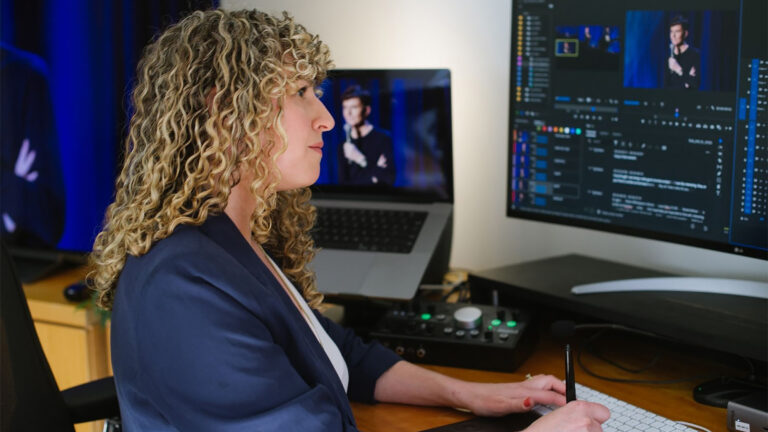Most of the VFX and editing team from Seth MacFarlane’s Peacock original series Ted should have known what they were in for when they signed on for the show. Editor Tom Costantino, ACE and assistant editor Justin Ulrich had already been across the universe with MacFarlane for his cult sci-fi favorite, The Orville, and VFX and puppeteering vet Blair Clark was the guy behind the bear for the Ted feature films, as well as VFX supervisor for Seth’s A Million Ways to Die in the West (2014).
Newcomer Allie Mitchell was not only taking her first tour of duty with Seth, but she was also learning VFX and puppeteering on the job, relying on her background in dance and theater. Together, the four brought a feature-level quality to Ted’s reintroduction on the small screen.
Plot summary for Ted
Set in 1993, in between the opening sequence in the feature film, Ted (2012), the series depicts the early life of a sentient teddy bear toy named Ted as he lives with John Bennett and his family in Framingham, Massachusetts. In addition to John and Ted, the Bennett household includes John’s father Matty, his mother Susan, and his cousin, Blaire, who is living with them while attending a college nearby. Ted is soon forced to attend school with John, getting him bullied and in all sorts of trouble.
In our discussion with the VFX and editing team from the series Ted, we talk about:
- Looking Back to the Features
- Stuffies and stunt stuffies
- Chrome balls, laser pointers and the trouble with eyelines
- Being a contortionist on set and in the cutting room
- How Stu the key grip saved the day
Listen while you read…
Editing Ted
Matt Feury: We are blessed to have a big and diverse crew with us today. I think the most appropriate way to begin things today is to talk about everyone’s role in the show. Blair, I thought we should start with you, since you came from the feature film Ted. Tell me about what you do on the series and how you got the gig.
Blair Clark: I am the visual effects supervisor on the Ted series. I got the gig because I was the visual effects supervisor on both features and Seth MacFarlane’s Western, A Million Ways to Die in the West. They knew the trouble they’d get into, so they figured, “Well, we know how to deal with him.”
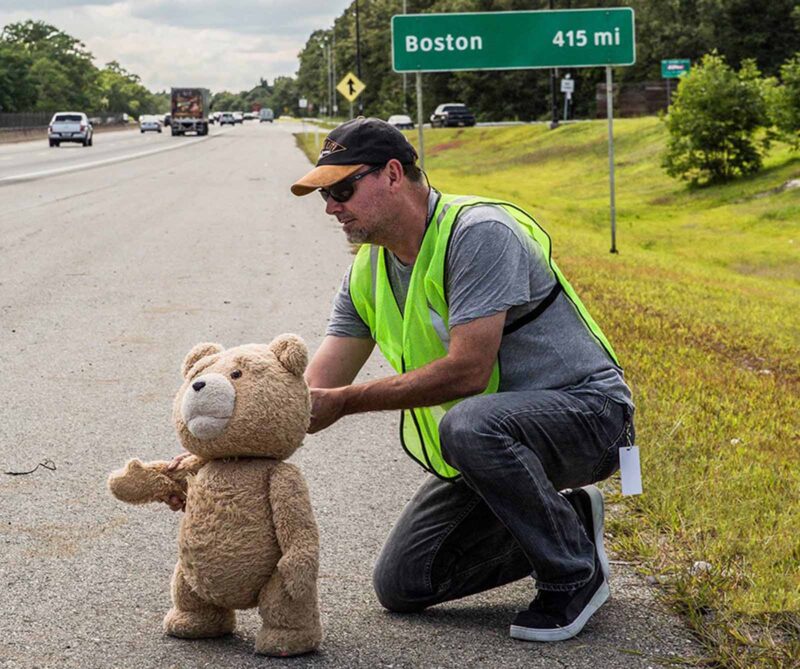
MF: I think there’s a lot of that in Hollywood. Speaking of which, Tom Costantino.
Tom Costantino, ACE: Hi.
MF: Apparently, Seth already knows how to deal with you. But tell me about your role on Ted and how you got the gig.
Tom Costantino: It was kind of similar-ish. I was on Seth’s little space show called The Orville. I was an editor then, then lead editor again, and then co-producer. Basically, they unplugged one NEXIS and plugged it into another.
MF: It’s that easy, huh?
Tom Costantino: Yeah.
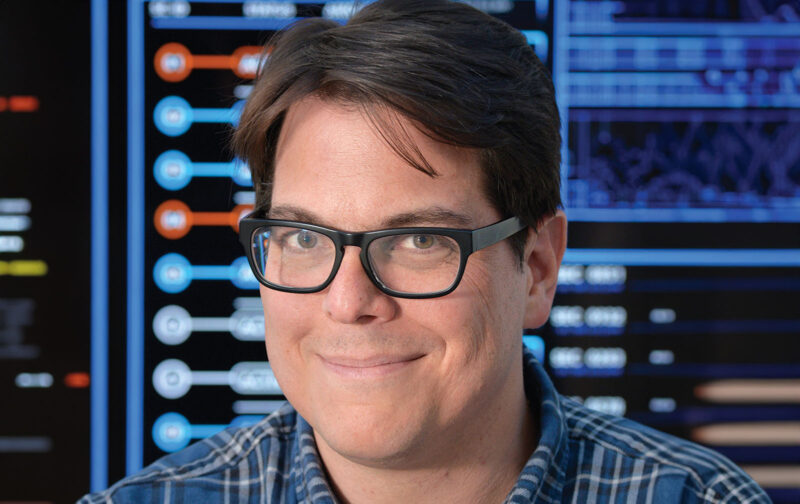
MF: Allie, we’ve already established that you probably weren’t alive when the feature Ted came out, and we’re all still recovering from that fact.
Allie Mitchell: Sorry.
MF: That’s sad. Tell us what you do on the series Ted and how you got the gig.
Allie Mitchell: So, I helped Blair with puppeteering on set, and then I worked as visual effects coordinator in post. I got the job through one of my college dance teachers who worked on The Orville. They asked for a recommendation of someone to help, and she recommended me. I had no puppeteering or visual effects background, but was willing to learn and they were telling Blair he needed someone to assist him. We worked together and they kept me on during post and I learned a lot.
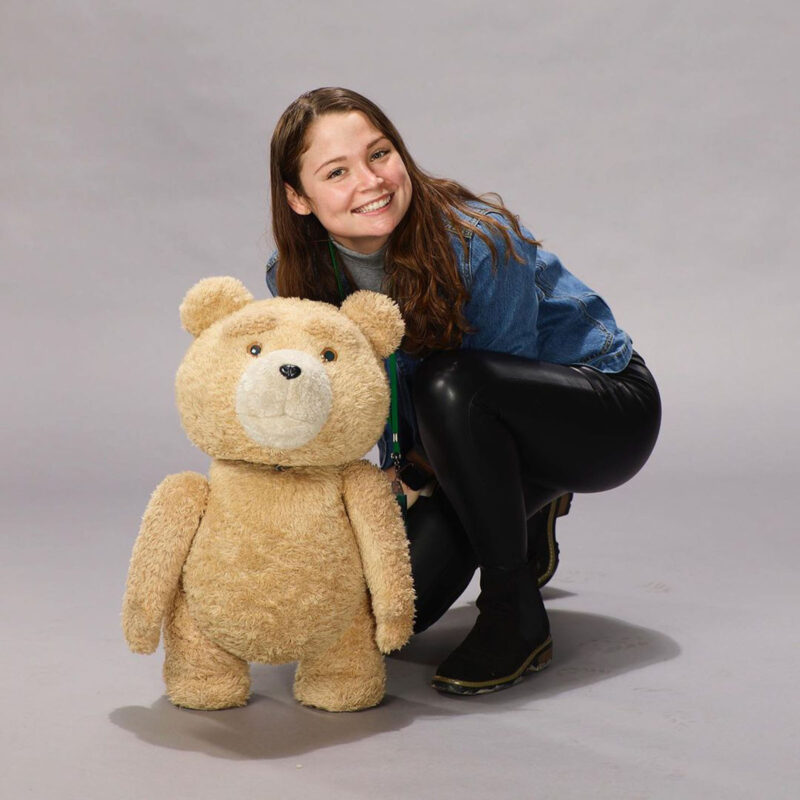
MF: I have to say, you have the distinction of being the first puppeteer I’ve ever had on the show.
Blair Clark: There’s two!
Allie Mitchell: Yeah, Blair was a puppeteer as well.
MF: Did you puppeteer as well? Are you credited that way?
Blair Clark: I did. I wasn’t credited on the series, but I think I am in the feature. At least one of them.
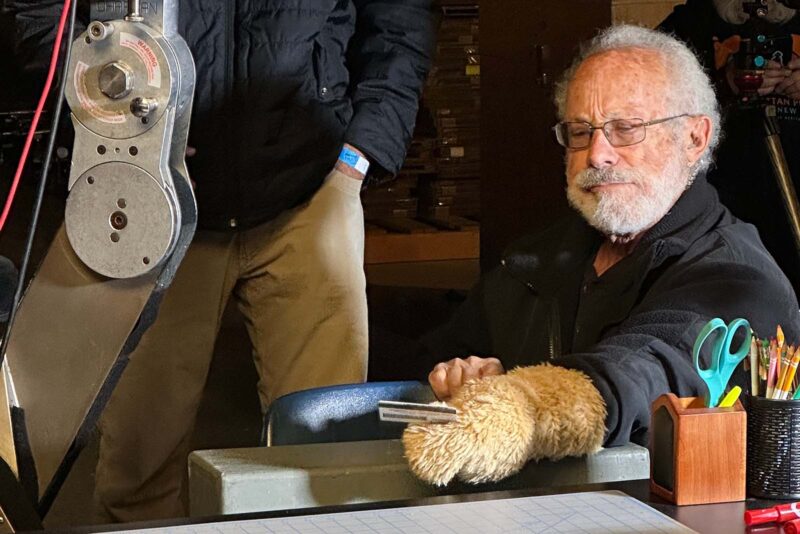
MF: Okay, that was it. And last but not least, first assistant Justin, tell us all about your role in the show and how you got the gig.
Justin Ulrich: I’m the first assistant editor on Ted. I just followed Tom onto Ted from The Orville directly. I think we had a week overlap and no downtime. So, three years with this guy.
MF: Oh my God. And you’re still smiling.
Justin Ulrich: Still smiling, somehow.
Blair Clark: And he’s our visual effects secret weapon.
Justin Ulrich: Yeah, I’m the in-house visual effects… I don’t know. Secret weapon. We’ll go with that. Thank you.
MF: I can’t let that pass. What does that mean?
Justin Ulrich: A lot of in-house opticals. I came up with a VFX background on some Netflix and other NBC shows. So, if we needed to paint a boom mic out at the last minute, that was me.
MF: So what you’re saying is a good first assistant can do a lot of different things?
Justin Ulrich: Sure.
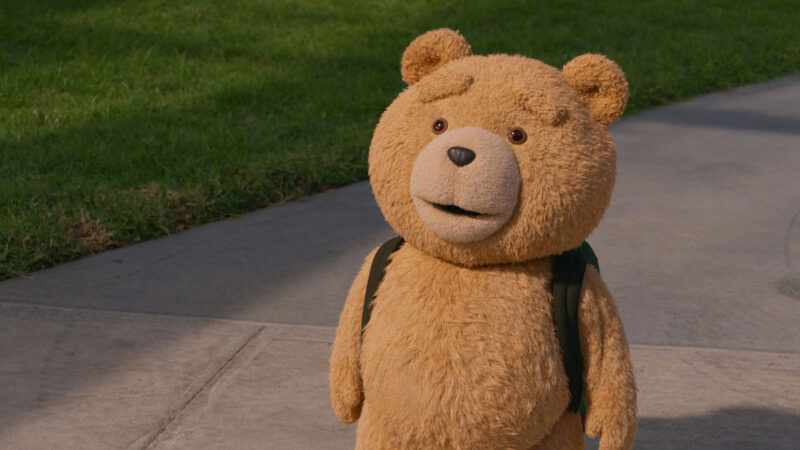
Tom Costantino: How many shots did you stabilize on House of Cards?
Justin Ulrich: That’s too many to count. In the thousands?
MF: All right, let’s go back to the Ted feature films. Blair, tell us about your experience on those. Were you able to draw from or leverage anything from working on those films?
Blair Clark: Yeah, absolutely. First and foremost, we were able to use the same companies that worked on the features. Framestore, which was at that point was Allura in Melbourne and Tippett Studio in Berkeley. Both of those companies worked on the Ted features, so already they had the lexicon of movement and character, and they developed the character Ted through those.
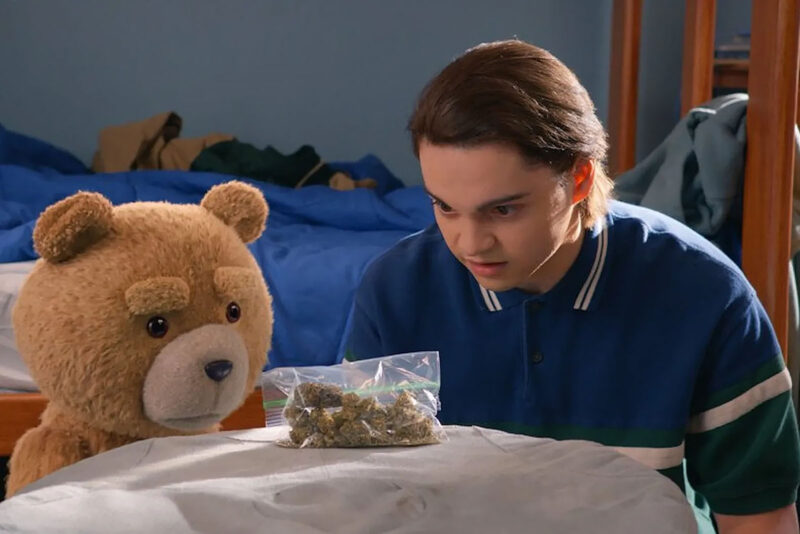
We benefited from having them on so we could use their experience. And they also had the Ted asset. That had to be kind of remade because it had outlived its longevity as far as technical things go. But they rebuilt it and redid the fur sim and shared it and it was great.
MF: Is the Ted asset a 3D file? What is a Ted asset?
Blair Clark: Yeah, it’s the 3D, CG character that would be rendered animated and rendered.
MF: So he was getting a little long in the tooth and had to be rebuilt better.
Blair Clark: A little bit. Yeah.
MF: Happens to all of us. For the rest of you who did not work on the feature, did you go back and watch the other Ted films to get a sense of the tone and visual style? Or was that not necessary?
Tom Costantino: I actually did. I saw them both, and I’m a big fan of Ted 2. I love when they go to the New York Comic-Con, but I didn’t watch it the same way. I looked at individual scenes and little character moments so I could have them in the back of my mind. You’re basically editing with an invisible plate. There’s just a plate full of nobody and nothing. So, you have to have it in your mind to sort of fill in the blanks.
MF: Allie, you’re literally bringing Ted to life. Did you look at those films to figure out how he moves and how you would apply your skills to that?
Allie Mitchell: First, when I was being interviewed for the job, Blair called me and wanted to make sure I knew the content of Ted. So, I rewatched it. I saw it when I was too young, but I rewatched it. Once I started working on the show in pre-production, I watched a lot of the behind-the-scenes videos from the features, which were very helpful because I got to see the puppeteering that Blair was doing and how that was applied to the animation.
MF: With a sci-fi show like The Orville, there’s going to be a lot of visual effects. However, I think anyone that ever saw the sets for that show would also be surprised how much detail goes into the practical aspects of it. At least I was.
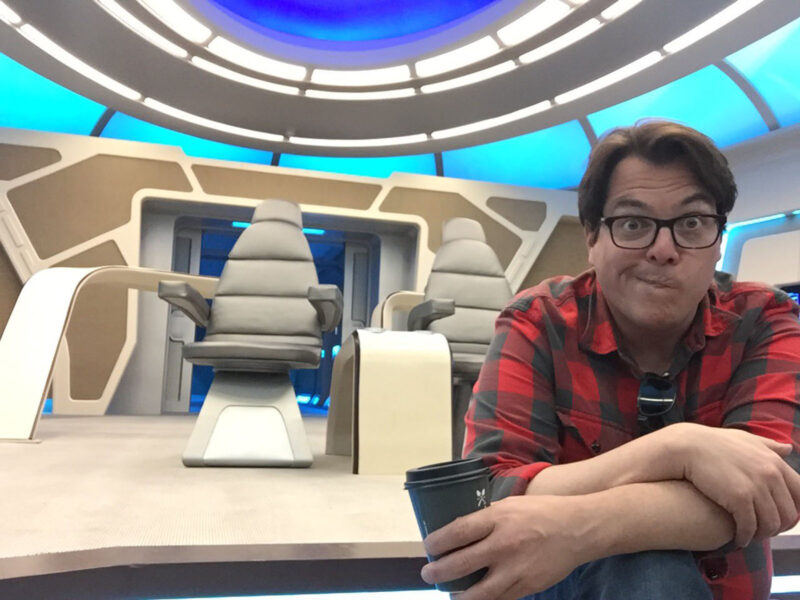
Ted is not in space, not this season anyway. It takes place in the past, but it would seem like the VFX load for Ted would be even greater considering that the star is in almost every shot. And the star isn’t actually there. How do those two shows compare from a VFX standpoint?
Tom Costantino: Actually, if you think about The Orville, around fifteen percent of it is CGI characters, so we did have the experience. This is fewer shots, but the amount of work that goes into those shots and the levels of working and reworking are very intense.
It’s good to know how to imagine a creature being in the frame, but Ted is the main character. The difference was that in The Orville, we would get the show together and then we would tweak the visual effects once the stuff came in. But on Ted we were doing multiple layers of editing as the bear advanced.
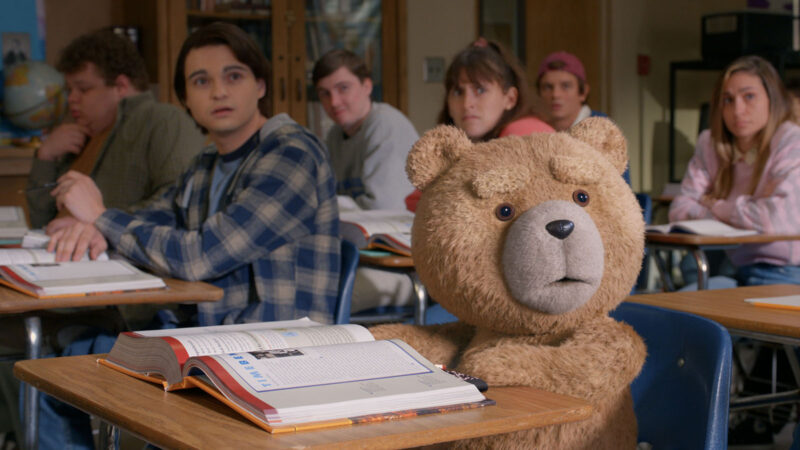
There were some other challenges that Blair and Allie can talk about, like turning things into 1993, snow, and all that other stuff. If you want to take it from there.
Blair Clark: The other thing about the features was the fact that he wasn’t there. That was a challenge for the actors as well. We would do a Stuffy pass with them, which was a little stuffed bear representation that was the same size as Ted and everything. One of us, usually Allie, would puppeteer the doll through the scene so the actors and camera operators could get a sense of the blocking. They would know, “Okay, that’s where he’s going to be during this part of the line.” But then during the takes, he wouldn’t be there.
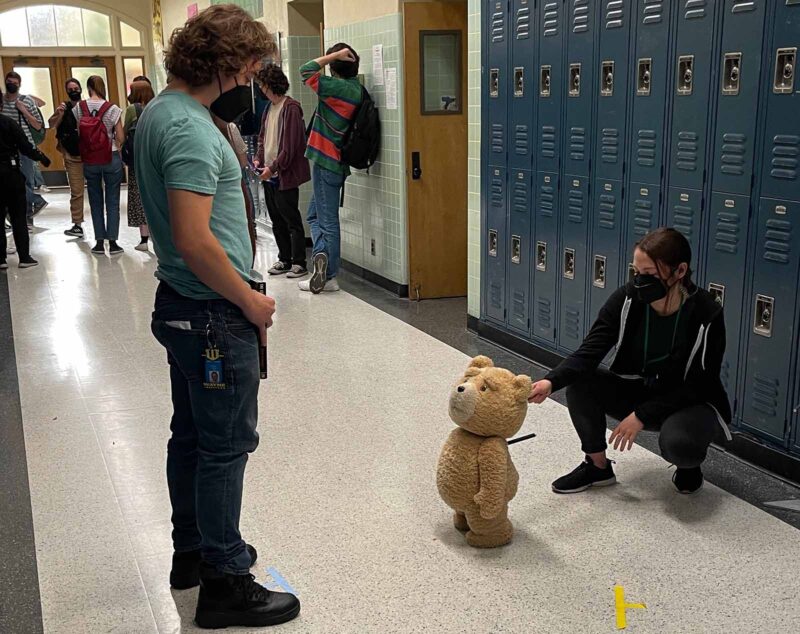
That’s usually okay if it’s a two-shot, but if you get multiple actors in the scene, trying to make sure that they’re all looking at the same spot can be tricky. You usually get one actor who’s probably amazing at everything, but for some reason, he’s looking three feet to the left of where Ted is. Then you have to try and motivate that in post in other ways. It’s tricky that way.
Justin Ulrich: I felt like The Orville was a lot more predictable. For example, if the characters are standing on the bridge in front of a blue screen, you know that stars are going to be in the background at some point. With Ted, there were so many shots that surprised me. The comedy motivated the animation. It was just a bit more unexpected, I’d say.
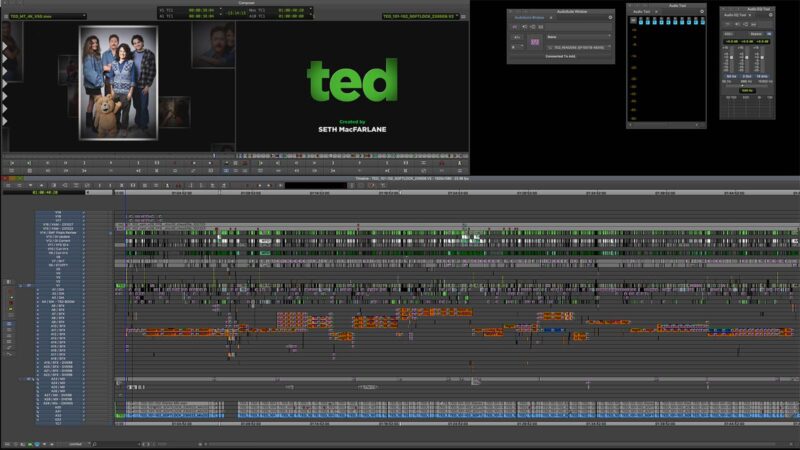
Tom Costantino: Seth was very serious about eyelines on The Orville, especially on the bridge, because we had eleven people all talking to each other. If the eyelines are off, it breaks the illusion of the conversation. So, that methodology was brought into Ted. It’s all about making the main character feel and be real. That attention to detail is pretty important.
Blair Clark: A lot of times during the Stuffy pass, you’ll be telling the actors, “Try looking at his nose. Look at his nose” and they’d like that. And then we take Stuffy away and most of the time they would hit it. We were fortunate that most of the actors were always really, really good as far as maintaining the eyeline and selling the fact that Ted was there.
It’s all about making the main character feel and be real.
MF: With any feature or TV series, there’s going to be varying degrees of connectivity between production and post. For something like this, it seems like it’s got to be just really tight. How do each of these shots work on set? What is the first step for each VFX shot? Do you always start with the Stuffy pass or does it start even before that?
Allie Mitchell: Before we would look at the script and see if there were any special needs for the scene. But for the most part, the first step would be the Stuffy pass. After that, they would go for the real take.
The cameras would always be rolling all the Stuffy passes so that the editors and animators could reference them. But the real take wouldn’t have Stuffy in it. Once they got all of their takes, we would do some lighting information passes like a chrome ball HDRI. We would do some environmental stuff if we needed to see shadows or Ted sitting on the couch. Sometimes we would push down on the cushions to make a dent for him. That was pretty much it for all the different passes.
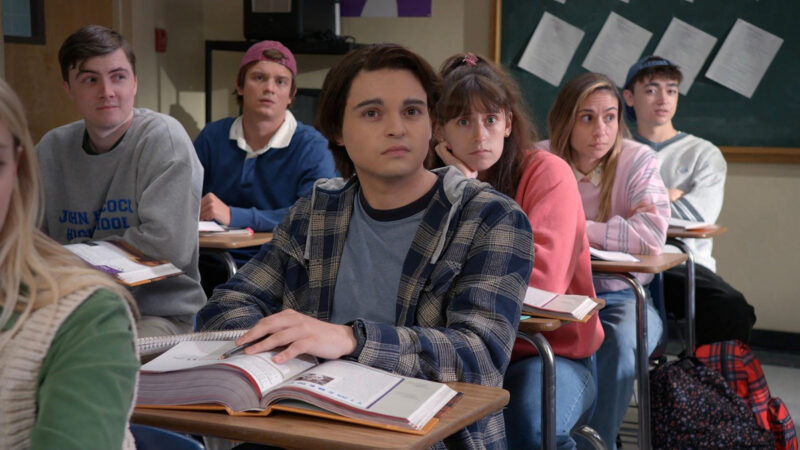
Justin Ulrich: Seth likes to roll take after take without cuts. So we would get a long take of three or four setups first. One of those was almost always the Stuffy pass. We would bill that as a Stuffy pass and then we would do the rough cut of the scene. Then, we would go back and put the Stuffy pass in the bottom right-hand corner of the screen so the animators could see it when Ted was on screen. We’d freeze-frame it if it wasn’t long enough. But that’s how we’d use that Stuffy pass after the initial cut of the scene.
Tom Costantino: Sometimes there were takes where three cameras were rolling and they’d have three plates. It’s sort of hard to know which plate is which, and then there’s always readjustment in the plate. So, you’d spend a lot of time working on the character, but I’m just imagining where Ted’s going to be and what he’s doing in the scene.
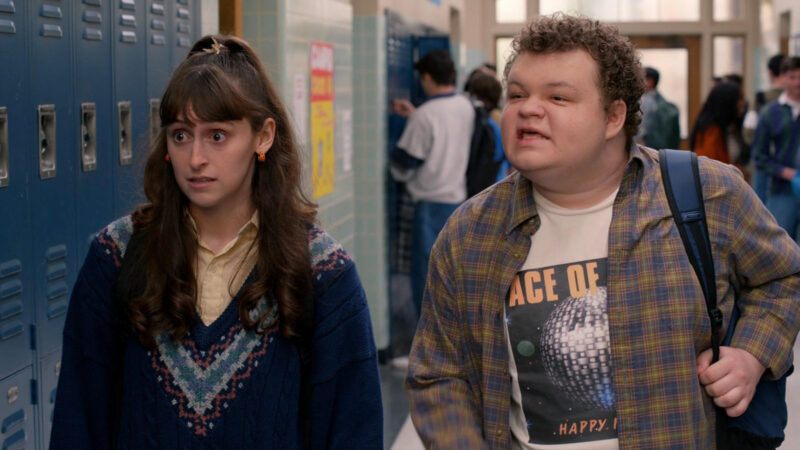
I think on set Seth is probably about seventy or eighty percent there. But as he’s working the scene, he’s evolving. When he comes in with me, we are both working together to create what we think Ted is going to be in what could be a seven-minute scene.
Later on, I would get into the refinement editing. At that stage, Ted was just a voice that Seth would record on set. Then he would rerecord it, pre-strike of course, for tone, acting, or punching up a joke. It took a little bit of experimenting because I couldn’t get good-quality audio. I was cutting to temp audio. Then we’d have to redo it once he was in the sound booth. Seth liked to run in and out of the booth to build the scenes out with his real Ted audio.
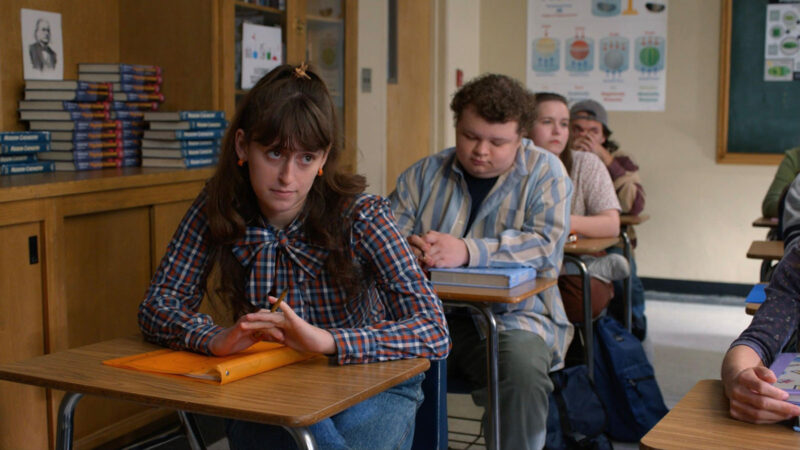
MF: You mentioned the three cameras. I never thought about that aspect of it. Blair, for a show like this with these VFX demands, does that require more cameras? Does it put a limitation on the number of effects you can have? Or does it not matter?
Blair Clark: When we’re shooting, you have to get all the information that you’re going to need. It’s all of the things that Allie mentioned, the reference stuff. You have to get that clean for each camera. After we see a cut that Tom does, we’ll kind of start to figure out how many shots we have. But we have to make sure that we have accurate information for each one of his camera setups.
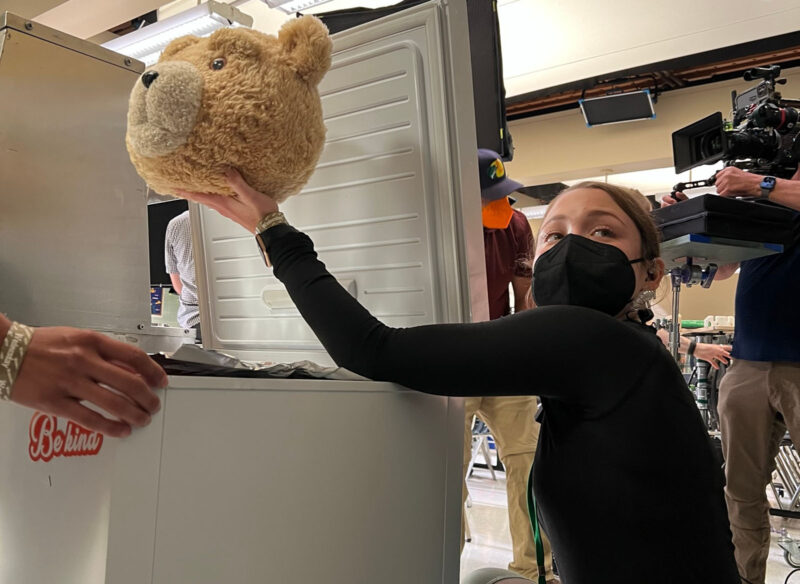
MF: Allie, you mentioned reading the script first and looking for any special needs. What defines a special need? Is it the way the actors would be interacting with Ted? Is it props? What do you look for?
Allie Mitchell: I mostly look for interaction and props. That’s one of the main reasons I was hired. When Ted holds something, it’s animated. But if Tom is in a scene and he holds it, it’s real. If Tom ever passes anything to Ted, we need to see that practical pass-off for the animators to be able to pick up from the practical handoff.
Any time Ted hands money to John Bennett or they’re handing a Coke can to someone, we need to have someone come in, grab the item as Ted, and then try to duck out of the shot. I spend a lot of time under tables and beds and all sorts of things, just grabbing something and hiding. Other times, if an actor is hugging Ted, sometimes we would use a piece of the Stuffy for that. I would try to fly it in as subtly as possible.
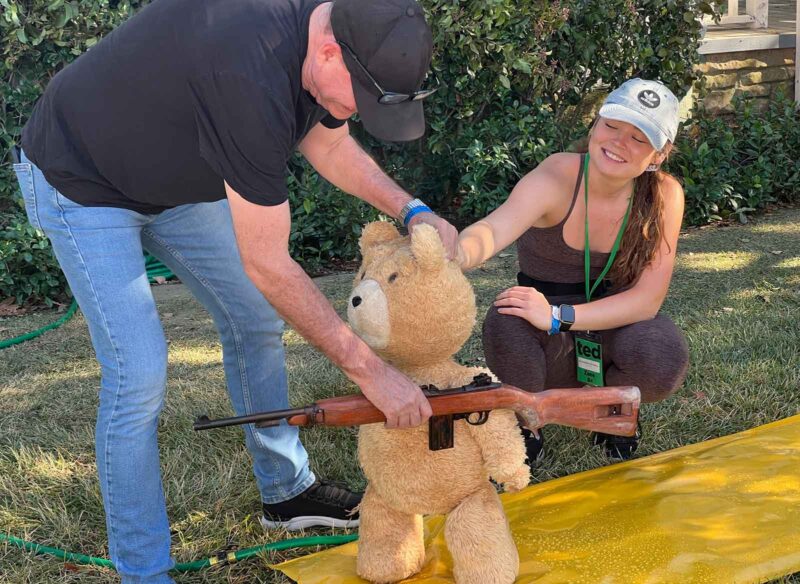
MF: You said that you hadn’t done puppeteering before. What skills in your background did you rely upon most heavily that you were able to employ working with Ted?
Allie Mitchell: I went to school for musical theater and it had a big emphasis on dance. I do yoga and aerial silks as well. So, just general flexibility and being able to move around and be quick on my feet.
Blair Clark: Wasn’t your onset titled The Contortionist?
Allie Mitchell: Yeah, I was referenced as The Contortionist when I was first hired. We had page-turn meetings and Seth didn’t know my name yet, so he was referring to me as The Contortionist. I kept looking at Blair, thinking, “I’m going to get fired because I’m not a contortionist!” I can do what the job needs, but I’m not a contortionist.
Tom Costantino: I have to say, there’s a lot of interaction in the final product, especially for a TV series. There’s a lot of interactivity with the CG character and real humans, and it’s flawless.
Justin Ulrich: I mean, they seamlessly hand off a transparent bong. It’s incredible. I just can’t tell.
Blair Clark: The VFX companies did a really good job with that. They would have to build a CG representation of the props because you don’t want to have it CG Through the whole time. If there’s a hand up for money, you don’t want to be animating and rendering that money when it’s in the actor’s hands. That’s why she would fly in and hand it to them and the shot could continue that way.
They seamlessly hand off a transparent bong. It’s incredible. I just can’t tell.
Framestore and Tippett did an amazing job with these props. The bong not only is transparent but it’s got water sloshing around in it and smoke coming out of it and stuff. All of that had to link up to when it transitioned to the real prop.
MF: Yeah. And Ted smokes a lot of weed in the show. Allie, I didn’t even want to go there with you and ask about that. And I don’t think Seth knows Tom’s name yet either, so don’t feel bad.
Tom Costantino: That’s not true.
Blair Clark: No, Tim was one of his favorite editors.
Justin Ulrich: He’s the post contortionist.
Tom Costantino: Tim’s a good editor. I’m proud to say that Seth knows everyone and is very appreciative of them.
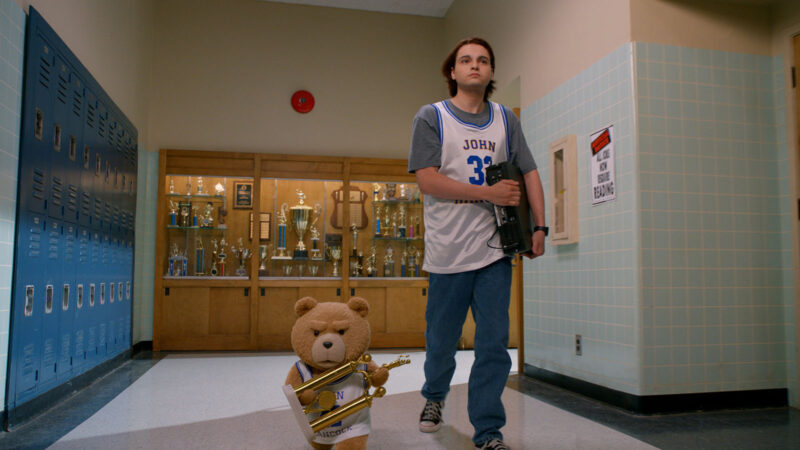
MF: I believe it. What extra elements did you get to help the on-set performance with Ted? I heard the letters HDRI. I know they’ll sometimes work with sticks with tennis balls on the end. What are those ancillary pieces that you work with on set that you have to keep track of?
Blair Clark: Usually, the sticks with the tennis balls on the end are for any kind of interaction with the actors. We had a lot of shots where Ted would be punching in or roughhousing with Mark Wahlberg, so we had to go in with tennis balls. It would kind of deform the clothes and give some interaction that the animators could key into later on and use to their advantage.
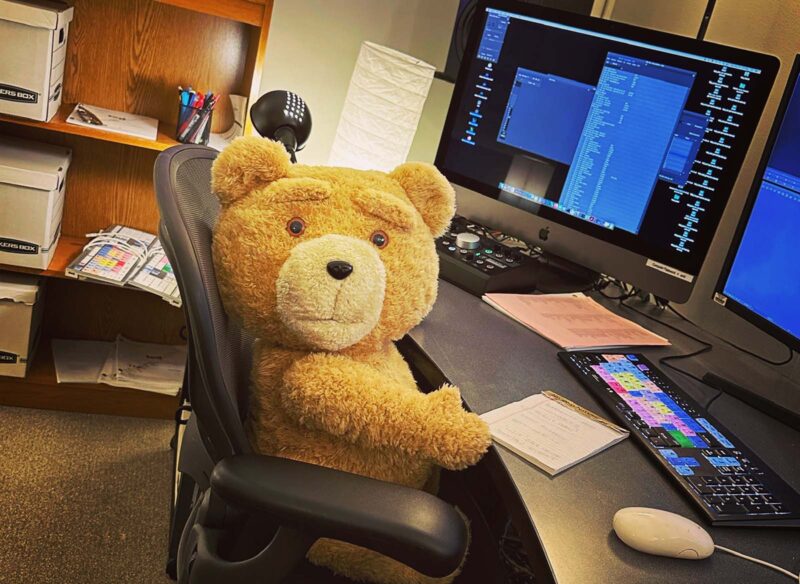
MF: Justin, are those other things that you have to keep track of? Does that introduce anything new to you or is it just like what you did on The Orville?
Justin Ulrich: It’s nothing like what we did on The Orville. This was very much a learn-day-of, figure-it-out-as-we-go kind of thing. We’d change our practice the following week if something made more sense timeline-wise. It was a lot of figuring it out as we went.
MF: Other than the older technology, like the sticks with the tennis balls, were there other tools that you used to help the actors interact with a nonexistent CG bear? I think somebody mentioned a laser pointer.
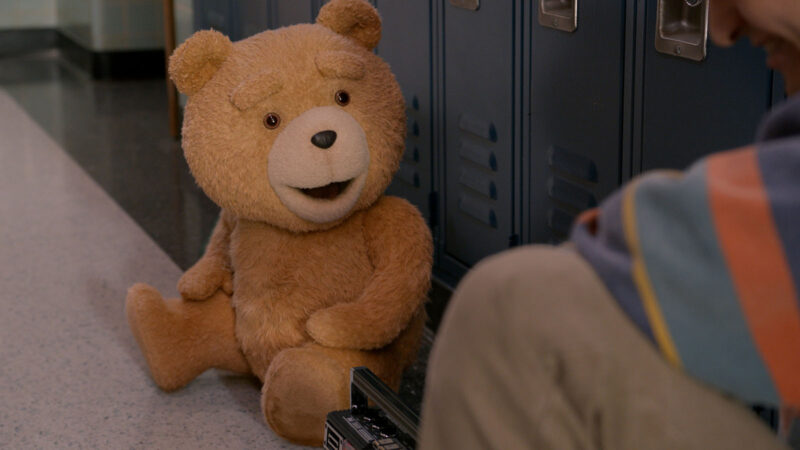
Blair Clark: The laser pointer was a good one, especially for scenes where Ted was going to jump off the couch and run across the room. I would usually be standing away from the camera with the laser pointer, just waiting. Then, as soon as he would run, I’d track him across the floor so their eyeline could follow the laser pointer. Generally, you would never register that they’re looking at a dot on the floor. It would just follow Ted.
Justin Ulrich: Did you guys use the eyeline tool?
Allie Mitchell: Yeah, we also had the eyeline tool, which is basically eyes on a stick, and you could adjust the height. We would put that in place if it was too difficult to keep the eyeline or if there were a lot of characters in the scene. And it was a lot easier for the animators to paint out the eyeline tool and put a head over than an actual Stuffy.
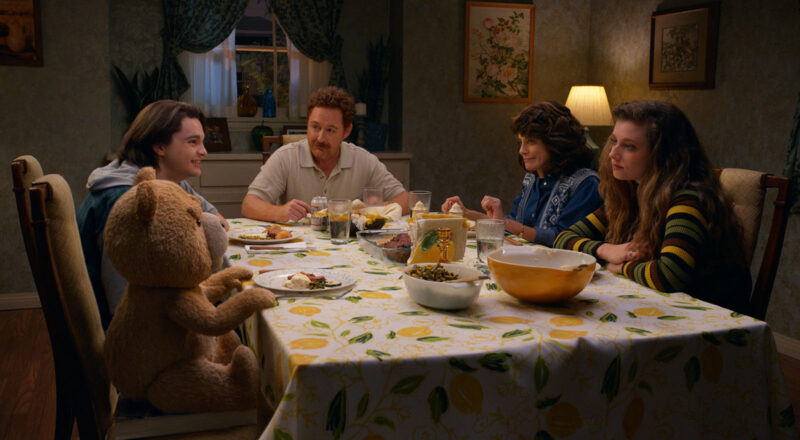
Blair Clark: Yeah, if Ted was stationary, we would put that in there. We could usually just cover it with the CG bear.
Allie Mitchell: Sometimes we would just put a little piece of tape somewhere to help with eyeline.
Tom Costantino: There was a lot of plate manipulation too. We did a lot of speed-ups. But once again, all of us, including Seth, were guessing. But Seth knew in his mind’s eye what the final product was going to be. So, we would rework plates to make sure that the animators had a fighting chance of getting the bear up the stairs in a funny way.
Seth knew in his mind’s eye what the final product was going to be.
There were a lot of people watching the cuts and they wouldn’t understand why there would be a long shot of a flight of stairs. The natural tendency was to cut it because it was slowing down the show. Seth, along with me and everyone here, was constantly fighting that instinct to not let Ted be himself, and that helped the end product. The eyeline seemed natural but we’d have to do stuff and then Justin would have to clean up the plate. And then obviously the VFX teams did amazing work.
MF: Justin is the VFX secret weapon. It seems like there is a need to make things look more finished during the earlier review cycles. We talked about what Blair and Allie did to try and make the process work better on set. But in post, how much effort are you putting in to try and clean that stuff up? Are you bothering to go in and remove, tweak, and shift things?
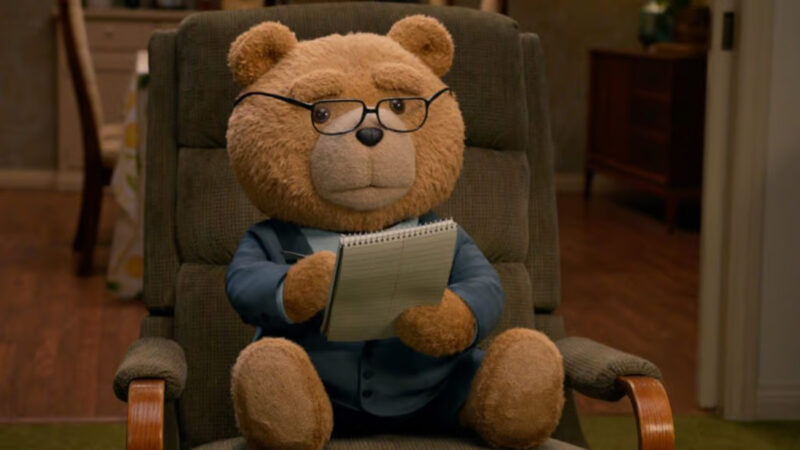
Tom Costantino: Well, here’s the thing. Normally, there’s a dog-and-pony show with studios where you want to make your most polished cut. We approached this show with a feature film mentality. We basically did two and a half feature films in a one-feature timeline.
We had a lot of sound design, but Seth and I would pull it out. That way, the animators were free to do things. The cuts were pretty dry. It was really focused so that Blair and Allie and the VFX companies could do their work. We knew what it was going to be. The studio would get it and say, “Are you going to put some music here? Is there going to be something coming down the stairs?” We had it in, but just to punch it up like you normally do.
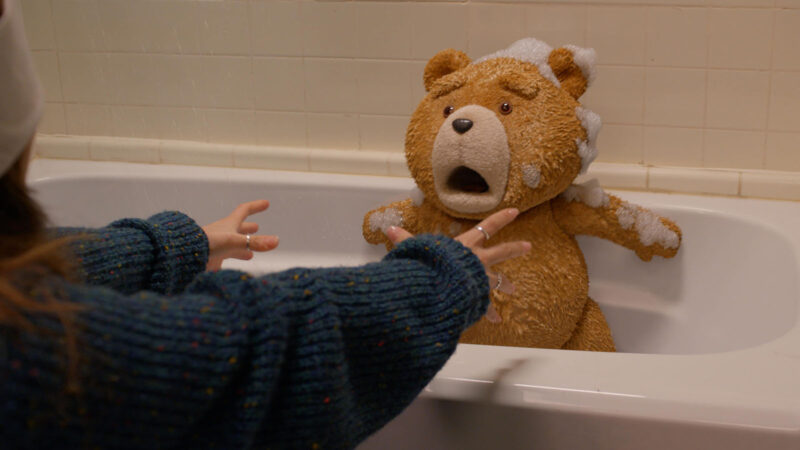
The only time we did a lot of work was on the pilot. There, we added Stuffies in and really polished that cut so that the studio could have the viewing experience. But it was more of an assembly factory to make sure that the end product was good versus having to please some people in the interim. And thank God for Seth. He’s done this before and he’s very successful. After a little bit of conversation, everybody let him just do his process. And I think the show is better for it.
Justin Ulrich: Early on, I built a Ted sound effects kit. It was footsteps and other foley that we used if he got up. Eventually, we just stopped putting those in because Seth said, “We don’t want that to motivate the animation.” So, as thorough as our sound work was, it was still just empty pockets of Ted, if he runs across the room.
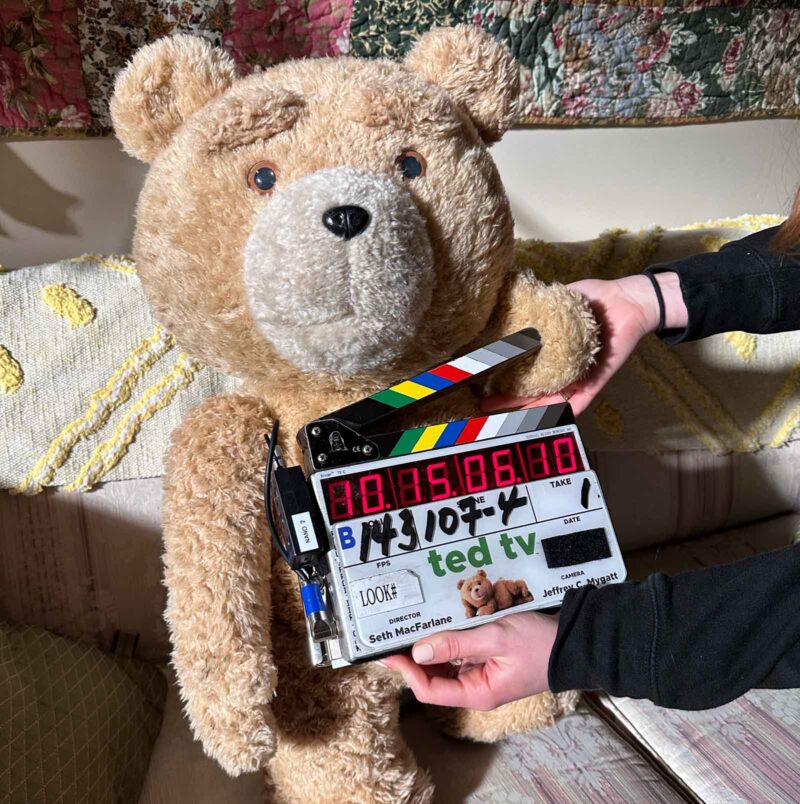
Tom Costantino: I was in Seth’s office early on, banging one of the leftover Ted 2 bears, making bear sounds and other mechanical sounds for my tool kit. By the way, sometimes Seth is very happy with our temps. He loves certain iconic things that help timing. We didn’t take that stuff out. But random bear footage or any of the stuff where I turned into Foleyman, we were limiting that.
MF: Allie, Since you were called The Contortionist, I want to ask, what was the most challenging scene or aspect of being Ted?
Allie Mitchell: There is a scene where Ted is trying to teach John how to take a bra off. He’s wearing a bra and he has tissue stuffed in it and he’s running around. First of all, the Stuffy pass was really scary. I was trying to run the bear around and Max, who plays Jon, was trying to chase me. But how do you replicate that without Ted?
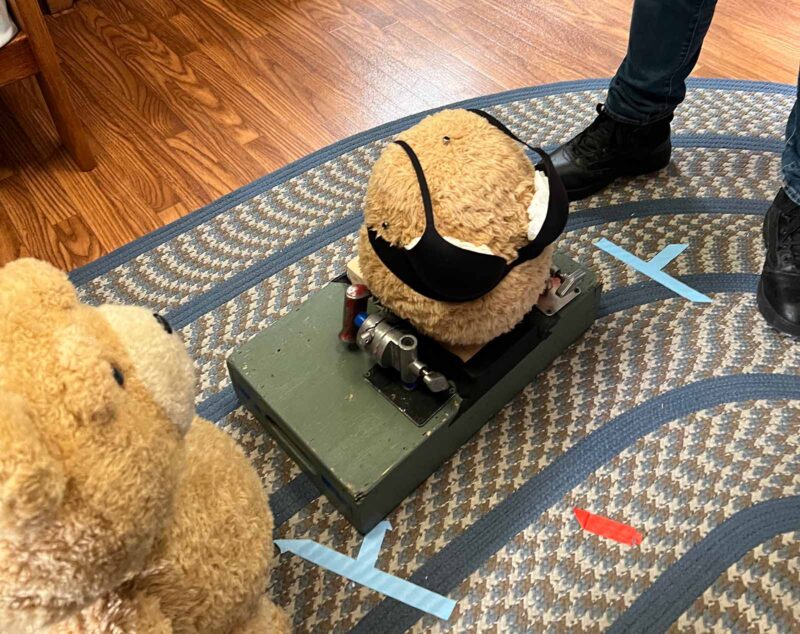
So, we got that part out of the way. I can’t remember if we use a laser pointer or if we just let Max do his thing. And then the animators were great. They just went along with it. Then, there is a point where the bra gets taken off and the tissues fall out. It was very difficult for the animators, I’m sure. We were trying to make it as easy as we could. We have what we call our “stunt Stuffy”. It’s the one where all of his body parts come apart. So, we just had his torso and we asked our key grip, Stu Abramson, to build a little rig for us.
Stu took an apple box and screwed in some stuff, and we put the torso on. Then we attached the bra so that the character could pull it off and the tissues could fall out. Then there was a point where we’re like, “Is that how you take a bra off?” It was a very interesting scene to film. I was so nervous about it, but it turned out great.
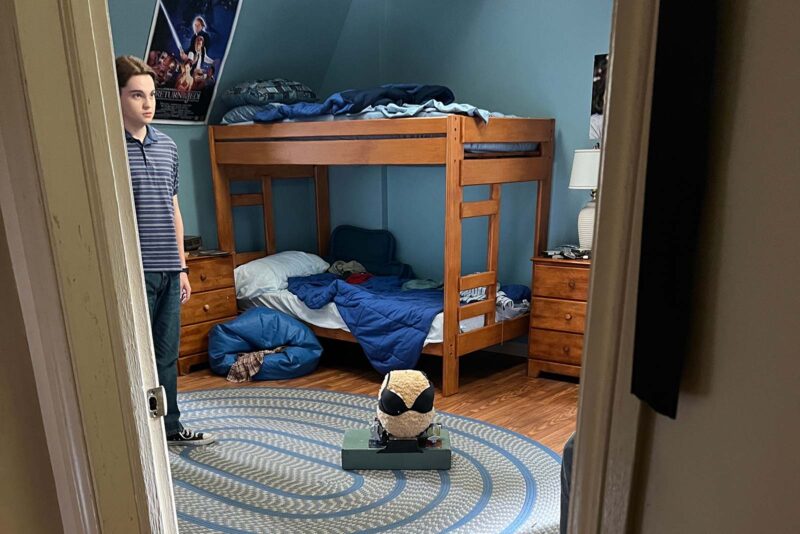
Blair Clark: Imagine a bunch of grips trying to figure out how to take a bra off.
Allie Mitchell: It turned into a conversation that we tried to end quickly. But I was thinking, “This isn’t how you take a bra off.”
Justin Ulrich: I remember one of the editors on the show called me in his office because we couldn’t figure out a turn. Ted just does a simple turn. And the coverage didn’t make sense to us because it was an empty plate. So that bra chaos followed us all the way through editorial.
Allie Mitchell: I’m pretty sure we had challenges with it when Ted was animated in it too, because we thought Ted was facing the wrong way. It was really hard to tell because the rug was so big and monotonous that we couldn’t tell where he was on the ground.
Justin Ulrich: It’s a chaotic scene. He’s just bouncing around.
Blair Clark: You get the three cameras and then the lines in the rug. All of a sudden it gets really confusing.
Tom Costantino: The eyeline tool and that bra disconnector thing, those were the two creepiest mechanisms. I don’t know if you’ve seen the E.T. that’s been in storage where all the other rubber is worn off. They look like that. So you’re already uncomfortable while you’re doing it. But thank God Bart Rachmil and Hillary Wills, my cohorts from The Orville, came in for a little while and we all conquered those scenes together. God bless them for helping.
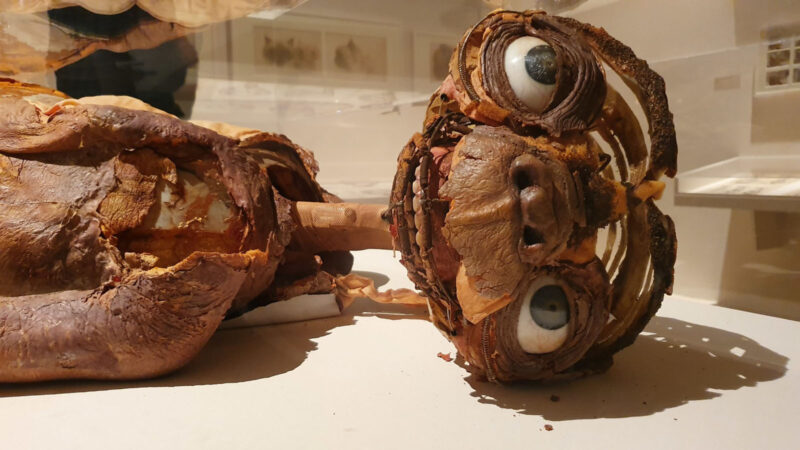
MF: Why is the Key Grip always named Stu? That’s what I want to know.
Blair Clark: There’s only one.
Justin Ulrich: There’s only one Key Grip.
Allie Mitchell: He’s worked on everything. And his son and his grandson were both on the set as well. So there was a whole legacy of Stus.
MF: I’m going to remember that. Legacy of Stus. I like that.
Allie Mitchell: Well, they weren’t named Stu.
Tom Costantino: Stu is delightful.
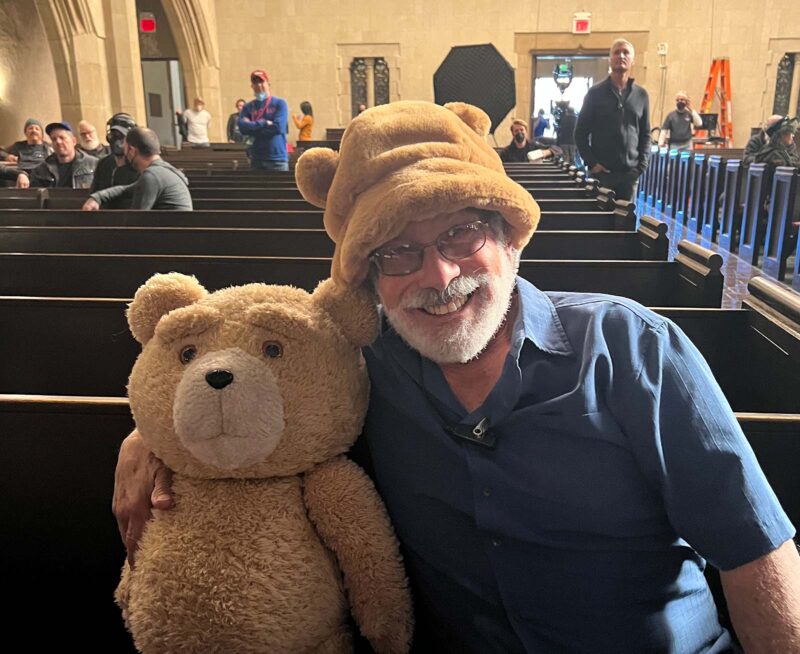
MF: Stu’s real people. Earlier, I think Tom said, “At some point, we’ll get into the stages.” I think we’ve touched on a lot of them, but why don’t we just sort of lay it right out there? Just what are the stages that you go through here?
Blair Clark: Well, Allie pretty much covered the on-set stages. After that, Seth will get in a mocap suit. He does pretty much all the scenes after the sound is cut and after everything is assembled so that he can perform it in situ. The mocap gives us a really solid place to start with the animation.
A lot of it is used exactly as it is. We usually take a little bit of license with things like facial expressions, mannerisms, hand gestures and all that stuff, just to emphasize certain things. But we always follow Seth’s timing because his timing is kind of amazing. It’s great watching him do this because he’s like a machine. It’s just…
Tom Costantino: Scary.
Blair Clark: It’s dead-on every time and very clear. A lot of times he’ll be trying to explain something to me and he’ll just say, “I’ll get it.” Then he performs and it’s so clear and perfect.
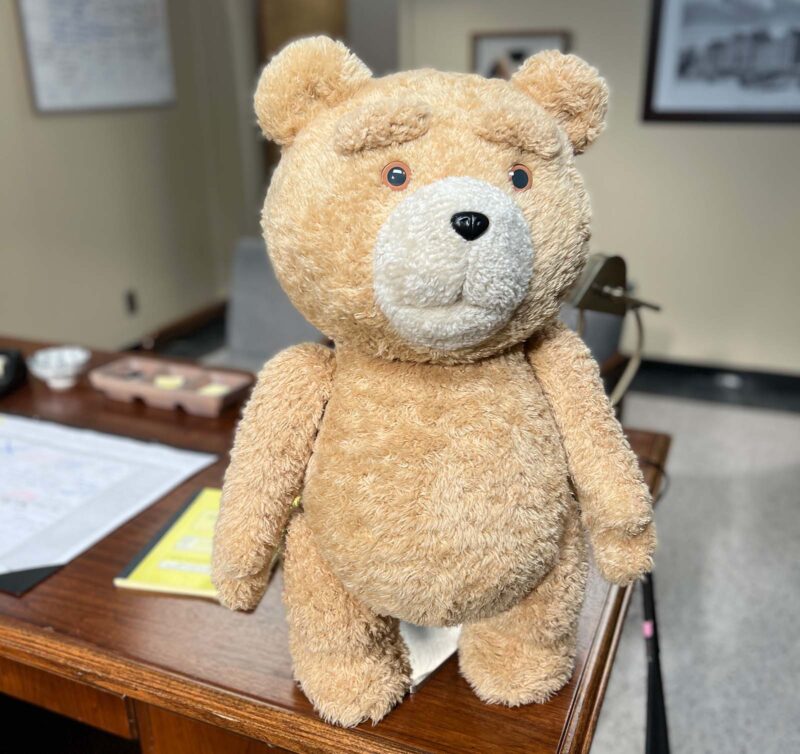
Tom Costantino: Sometimes we watch it with Seth so he can throw questions at all of us. We’d be behind the mocap equipment, just taking notes and stuff. But sometimes when I was looking down or God forbid, I had to answer somebody on Twitter about The Orville, which I have cut cold turkey, I would hear what I thought was playback over and over again. But it was Seth redoing the lines, acting to the literal frame and tonality as to what was in the scene. Again and again and again.
Blair Clark: It’s amazing.
Tom Costantino: Yeah, it’s pretty wild. And very helpful.
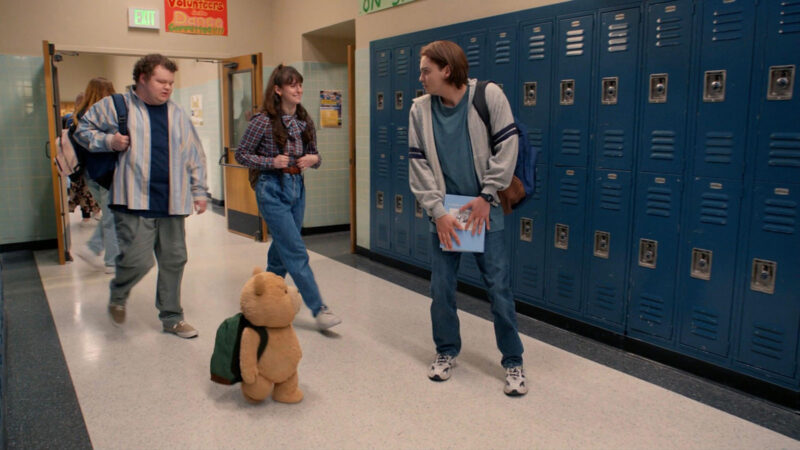
Blair Clark: So the mocap and the cuts get sent to the companies and then they start the animation process. They block it first, then we can make sure that Ted is doing what he needs to do and covering all the beats and everything. Then, they refine it over a series of processes. We have temp animation and final animation, and then we get into lighting and compositing. It’s a whole process. Each shot goes through a pretty severe detailed process from the beginning to the final render. Then it goes back to Tom.
MF: Before Tom goes into his stages, just hearing you talk about all that, it must take forever to do this show. How long does it take to do an episode of Ted?
Justin Ulrich: I don’t know if we can answer that question, honestly. Eighteen months?
Blair Clark: Sixteen? I mean, we didn’t work on every show. Everything was happening at the same time. It was scheduled in a waterfall kind of way.
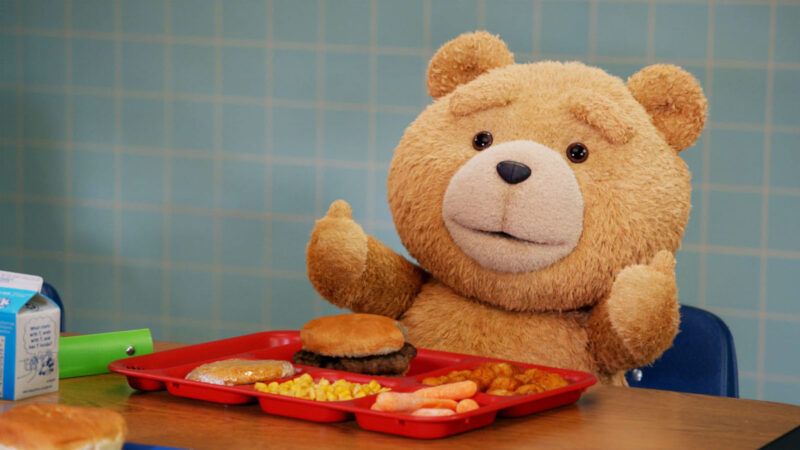
Tom Costantino: I think you have to look at it as there’s no degradation or there’s no loss of quality. If anything, there’s parts of it that are better than the features from a visual effects standpoint. So, you really have to think that we cut two and a half features in the timeline of one feature.
Somehow, we did an editorial post and the VFX team managed without any loss of quality. Seth is obviously understanding, but he believes in a very high level of production. It’s not like standard TV where you shoot for eight days and we do our thing. We’re constantly working in an open flow.
MF: Since you brought up comparing it to the Ted feature films, Blair, is the process the same from a VFX standpoint?
Blair Clark: Yeah, it turned out to be. This was my first TV series because I’d always done features. I was a little nervous going in because I’d heard stories about how TV is different and it’s a lot more fast-paced. It ended up being more like a feature film. Even people on set were commenting, “This is more like a feature.” So it really didn’t change for us. The schedule was the big thing. We followed all the same steps, it was just truncated into a very small timeline.
Tom Costantino: There were a couple of things. We had people at the studio who believed in the product, and who understood the level we were working at. And we have Seth, who has the clout to make sure that things happen. I’ve seen lesser productions get crushed on that.
Early on, at least from a production and post standpoint, there were attempts to build a better mousetrap, but you can’t rush quality. The feature method worked the best.
Blair Clark: Seth was pretty stringent as far as quality control. He wouldn’t let anything just slip, which none of us wanted. He was the guardian that we could all go to. He won’t make us sell the quality short. It needs to be right.
There were attempts to build a better mousetrap, but you can’t rush quality.
Tom Costantino: Trying to sell something half-assed, he just won’t do it. Seth respects all of us working at the level that he works at.
Blair Clark: I’ve seen people try and do it and it’s always the same. You get to know his responses pretty fast.
Tom Costantino: Someone’s selling bad wares again!
Blair Clark: And they’ll walk away thinking, “Okay, he bought it!” and everybody else is thinking, “There’s no way.”
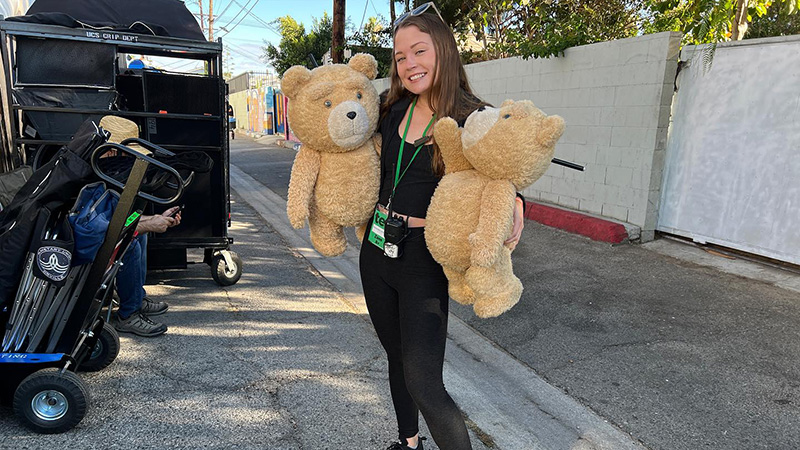
MF: Tom, what were the rest of the phases on the post side?
Tom Costantino: I want to compliment Justin, the master of the turnovers. There was so much interactivity in addition to the fact that he was doing all these 15,000 other roles and his first co-edit role on the Christmas episode.
Justin Ulrich: Very exciting.
Tom Costantino: On a regular show, you got the editor’s cut, you got the director’s cut, you got the producer’s cut, and got the studio network cut. Because we’re sort of internal, we would show the studio the progress. But it could only go so far because I was working with temp audio. Then, Seth and I would do our thing like we did on The Orville. We would re-record some of the dialog, punch some stuff up, figure out camera angles together, and we’d work through some scenes. That’s what went off to VFX to start. After that, they would do their process, put the mocap in, and get that going.
As shots were coming in in temp phases, Seth would do a review and then we’d go back in and recut the show over time, rebuilding the sequences, pulling frames, speeding up plates, and sometimes speeding up to help the gang out. We’d make these janky edits into the animation. We would pull frames or make hands move faster.
They did amazing stuff on their own, but sometimes it was easier for Seth to do it with me to get his point across. And then that would go to Justin and to the VFX team to get another shot. Then, we would recut the show for timing. That was the final pass. We’d pull air out and change a few things, lose a couple of shots.
There were shots that Seth or I put in that we thought would be something more, but then it didn’t need to be there once the character was in. That would be our final comedy pass, for lack of a better term. There were probably five separate edits over time.
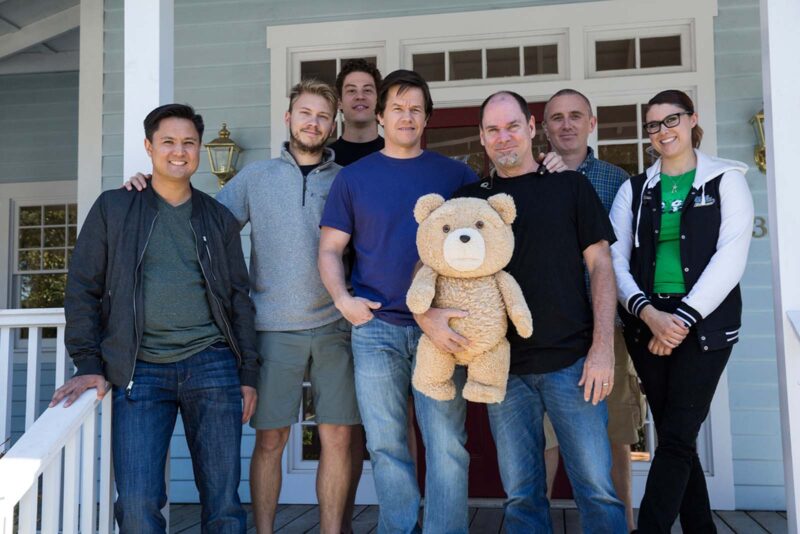
MF: We talked a lot about Ted the character, the work that Blair and Allie have to put into making him work on set. Other than the character, what other visual effects did you have to worry about?
Blair Clark: We had another character in one episode, Dennis the Dump Truck. We had a separate company, Fuse, work on that and they did an amazing job. Dennis is an inanimate object that comes to life. He’s a toy truck. Seth wanted minimal movement. He didn’t want it to go full cartoon or full Pixar. So, we kept the movement just around the bumper and in the front of the grill. Fuse did a great job with that. He’s a feisty Archie Bunker-type of character. There’s a lot of character to work with.
Allie Mitchell: Blair puppeteered him mostly with this long metal rod. There is a scene where Dennis is on the couch. Stu ended up cutting a hole in the couch so Blair would be able to puppeteer.
Justin Ulrich: I remember finding that hole in the couch during dailies. I thought, “What is that? Oh, it’s a hole.”
Allie Mitchell: The stuffing was everywhere.
Tom Costantino: Those scenes were more fun to cut because there was an actual truck being moved by Blair. I was able to look for things where the truck would do a little something. It was more traditional editing. It was a nice break from it all. Also, there was a lot of split-screen work, which was handled by the VFX teams. They used that to change timings and stuff. Then we had snow.
Blair Clark: Yeah, a lot of environmental stuff. The snow was a big one. One of the episodes takes place in the winter. We had to snow up a non-snowed section of town.
Justin Ulrich: We snowed up the house during the middle of the heatwave last August, right?
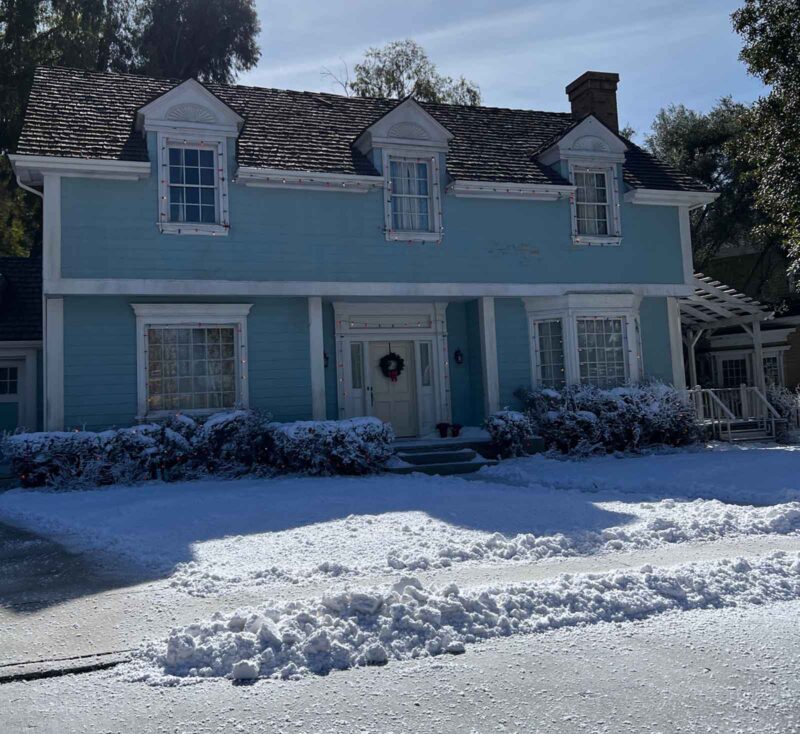
Blair Clark: Yeah, exactly. The practical effects guys did a great job with putting snow around the action areas and on the lawn. But we had to do…
Allie Mitchell: Tree replacements and all that.
Blair Clark: There were a lot of full green trees. Seth was wondering, “How are we going to handle that?” I said, “We can suck the color out of them and make them a little more autumn.” I was trying to avoid having to replace the whole tree because then you have this bare tree and you’ll have to see the whole neighborhood behind the tree that it’s occluding. That’s what we ended up doing and it looks great.
Allie Mitchell: I remember being on set and they would always ask Blair, “Do you have the artwork for this? Do you have the artwork for this?”
Tom Costantino: There’s a lot of taking California and making it Framingham, Massachusetts. There’s a lot of East Coast tree work that no one will ever notice. It’s flawless. Did Fuse do that?
Blair Clark: The stuff shot in Griffith Park was Framestore.
Allie Mitchell: Framestore did the establishing shots in some of the episodes and Fuse did the rest. They split up the work.
Tom Costantino: That load alone is enough to keep a show going. And then we had a fully realized main character. It’s a lot to imagine as you go.
Blair Clark: You read a lot of things in the script and you don’t think there’s any visual effects. Then you’re told while you’re shooting a long scene in Griffith Park that none of these trees are East Coast trees. So you’re going to have to change those trees.
Tom Costantino: And then locations would find a video store and it’s fine. But then you have to make it a 1993 video store and that’s a credit to them. And driving plates.
Justin Ulrich: Driving plates.
Blair Clark: Yes.
Allie Mitchell: I blocked that out.
Tom Costantino: Period-appropriate driving plates. Sometimes, on top of a car, which means you have none of the things that help you fake it. And credit to Seth again, you know, bad Translights and crappy driving plates drive him crazy. You’re trying to focus on the comedy and then you know that they’re not actually in the car. In the Ted movies, a lot of the time they shot in the car. Right, Blair?
Blair Clark: Some of it, yeah. If we did do a driving plate, it would be scheduled so that we shot it in the same path using the same lighting and all that. It was a little different.
Tom Costantino: It was one of those things, again, where we were trying to build a better mousetrap. In the end, there was a lot of high-level work and I think the car scenes all look extremely real. That is helpful, especially when Ted is drunk and decides to crash the car in the Halloween episode.
MF: We talked a lot about visual effects and with good reason. We should shift a little bit to the story itself. When you’re watching a Seth Macfarlane project, it’s always about pushing the envelope. Do you ever have to dial it back a little?
Tom Costantino: The network and the studio were pretty good about letting the comedy be. The trick was, and this is because it’s impossible, there were a lot of pacing notes. The bear was just not there in some of the cuts they got. Ted was just a voice and a plate.
They had a couple of good suggestions narratively and they would also give notes like, “There’s one too many joke runs.” But the brain trust was Seth. He’s been doing this for a long time. We didn’t have to ever pull back. On a couple of occasions, the studio and network even asked us to take it a step further.
Blair Clark: It certainly doesn’t seem like it’s pulled back.
Tom Costantino: It took time for everyone to get used to it. They’re used to seeing cuts with all the characters in and all the sound design and all that. Then here we were saying, “Here’s forty-two minutes of people talking to a stick!” Our sound design was mostly fleshed in though. We had the mix team from The Orville, Jon Greasley and Tom Ozanich. They did an amazing job.
MF: Each of you came into this with certain skills that you could apply. But for all of you, what did you learn from Ted that you can walk away with?
Justin Ulrich: I’d say the biggest thing I’m walking away with is a sense of empowerment. Everybody on this show was kind of figuring it out as we went. We came in with a stubborn attitude of, “I’ll figure this out regardless of what time I leave tonight.” Now I feel like I can do anything.
Tom Costantino: Also, trust the process. It’s unnerving to bring a feature film application to the television mindset. I was pretty dug-in thinking that it was going to work. But once in a while, I’d think, “I don’t that’s that’s it. That’s a long walk up the stairs.”
If we had a time where it didn’t work, either Blair or the VFX gang would make it better. Sometimes they would combine two different concepts, like when Ted falls down the stairs. Or we’d trim it up or change it around. There was room to play. So, just trust the process.
Just trust the process.
I think this would be a great learning opportunity for an editor that only cuts strictly non-visual effects. The machine moves pretty fast, so the learning curve is steep. You can be a really great comedy editor on a show like this or even a drama editor. But if you can’t understand the technicals and the organic nature of putting it all together, you can get swallowed up pretty fast.
Allie Mitchell: I had no visual effects background coming into this. I learned the entire VFX process of this show from pre-production to post. When I was on set, sometimes people would ask me about the gray ball I was holding. Thanks to Blair, I could answer them. It was a great learning experience. Blair taught me so much. I hope to work with all of these guys again.
Blair Clark: I’m the same way. Every show is different. We definitely became a family on this one. And Seth is always enjoyable to work with. He’s amazing to watch and to learn from. I learn something on every single show and it’s always different. The only constant thing is the notes I have to give to the company. “You need to enunciate the F in that in that word.”
MF: I’m not even going to ask what that word was.
Blair Clark: It’s always the same.

